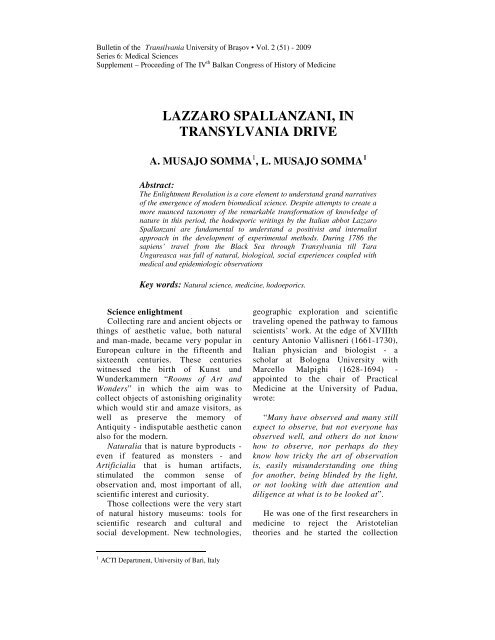Series VI: Medical Sciences – SUPPLEMENT ... - Krongres
Series VI: Medical Sciences – SUPPLEMENT ... - Krongres
Series VI: Medical Sciences – SUPPLEMENT ... - Krongres
You also want an ePaper? Increase the reach of your titles
YUMPU automatically turns print PDFs into web optimized ePapers that Google loves.
Bulletin of the Transilvania University of Bra�ov • Vol. 2 (51) - 2009<br />
<strong>Series</strong> 6: <strong>Medical</strong> <strong>Sciences</strong><br />
Supplement <strong>–</strong> Proceeding of The IV th Balkan Congress of History of Medicine<br />
LAZZARO SPALLANZANI, IN<br />
TRANSYLVANIA DRIVE<br />
A. MUSAJO SOMMA 1 , L. MUSAJO SOMMA 1<br />
Abstract:<br />
The Enlightment Revolution is a core element to understand grand narratives<br />
of the emergence of modern biomedical science. Despite attempts to create a<br />
more nuanced taxonomy of the remarkable transformation of knowledge of<br />
nature in this period, the hodoeporic writings by the Italian abbot Lazzaro<br />
Spallanzani are fundamental to understand a positivist and internalist<br />
approach in the development of experimental methods. During 1786 the<br />
sapiens’ travel from the Black Sea through Transylvania till Tara<br />
Ungureasca was full of natural, biological, social experiences coupled with<br />
medical and epidemiologic observations<br />
Key words: Natural science, medicine, hodoeporics.<br />
Science enlightment<br />
Collecting rare and ancient objects or<br />
things of aesthetic value, both natural<br />
and man-made, became very popular in<br />
European culture in the fifteenth and<br />
sixteenth centuries. These centuries<br />
witnessed the birth of Kunst und<br />
Wunderkammern “Rooms of Art and<br />
Wonders” in which the aim was to<br />
collect objects of astonishing originality<br />
which would stir and amaze visitors, as<br />
well as preserve the memory of<br />
Antiquity - indisputable aesthetic canon<br />
also for the modern.<br />
Naturalia that is nature byproducts -<br />
even if featured as monsters - and<br />
Artificialia that is human artifacts,<br />
stimulated the common sense of<br />
observation and, most important of all,<br />
scientific interest and curiosity.<br />
Those collections were the very start<br />
of natural history museums: tools for<br />
scientific research and cultural and<br />
social development. New technologies,<br />
1 ACTI Department, University of Bari, Italy<br />
geographic exploration and scientific<br />
traveling opened the pathway to famous<br />
scientists’ work. At the edge of X<strong>VI</strong>IIth<br />
century Antonio Vallisneri (1661-1730),<br />
Italian physician and biologist - a<br />
scholar at Bologna University with<br />
Marcello Malpighi (1628-1694) -<br />
appointed to the chair of Practical<br />
Medicine at the University of Padua,<br />
wrote:<br />
“Many have observed and many still<br />
expect to observe, but not everyone has<br />
observed well, and others do not know<br />
how to observe, nor perhaps do they<br />
know how tricky the art of observation<br />
is, easily misunderstanding one thing<br />
for another, being blinded by the light,<br />
or not looking with due attention and<br />
diligence at what is to be looked at”.<br />
He was one of the first researchers in<br />
medicine to reject the Aristotelian<br />
theories and he started the collection


